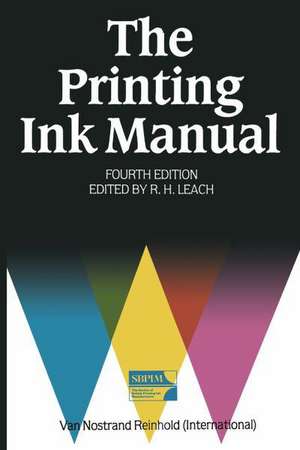The Printing Ink Manual
Autor Robert Leachen Limba Engleză Paperback – 9 apr 2012
| Toate formatele și edițiile | Preț | Express |
|---|---|---|
| Paperback (2) | 669.52 lei 6-8 săpt. | |
| Springer Us – mar 2012 | 669.52 lei 6-8 săpt. | |
| SPRINGER NETHERLANDS – 9 apr 2012 | 918.17 lei 6-8 săpt. |
Preț: 918.17 lei
Preț vechi: 1119.72 lei
-18% Nou
Puncte Express: 1377
Preț estimativ în valută:
175.68€ • 183.45$ • 145.08£
175.68€ • 183.45$ • 145.08£
Carte tipărită la comandă
Livrare economică 15-29 aprilie
Preluare comenzi: 021 569.72.76
Specificații
ISBN-13: 9789401170994
ISBN-10: 9401170991
Pagini: 892
Ilustrații: XIV, 872 p. 141 illus., 4 illus. in color.
Dimensiuni: 155 x 235 x 50 mm
Greutate: 1.23 kg
Ediția:Softcover reprint of the original 1st ed. 1988
Editura: SPRINGER NETHERLANDS
Colecția Springer
Locul publicării:Dordrecht, Netherlands
ISBN-10: 9401170991
Pagini: 892
Ilustrații: XIV, 872 p. 141 illus., 4 illus. in color.
Dimensiuni: 155 x 235 x 50 mm
Greutate: 1.23 kg
Ediția:Softcover reprint of the original 1st ed. 1988
Editura: SPRINGER NETHERLANDS
Colecția Springer
Locul publicării:Dordrecht, Netherlands
Public țintă
ResearchCuprins
1 The Nature of Printing Inks.- 1.1 Visual characteristics of inks.- 1.2 The nature of printing inks as determined by the printing process.- 1.3 The drying characteristics.- 1.4 The adhesive nature of printing inks.- 1.5 The resistance properties of printing inks.- 2 The Printing Processes.- 2.1 The letterpress process.- 2.2 The offset lithographic process.- 2.3 The gravure process.- 2.4 The flexographic process.- 2.5 The screen printing process.- 2.6 Non-impact printing processes.- 2.7 Other printing processes.- 2.8 Print recognition.- 2.9 Substrate selection.- 2.10 The need for communication.- 3 Colour and Colour Matching.- 3.1 The physical nature of colour.- 3.2 The perception of colour.- 3.3 Additive and subtractive colour mixing.- 3.4 Origins of colour in printed material.- 3.5 Graphic reproduction.- 3.6 The measurement of colour.- 3.7 The recording of colour data and the specification of colour.- 3.8 Colour matching.- 3.9 Instrumental colour match prediction.- References.- 4 Raw Materials.- Section I Pigments.- Section II Dyestuffs.- Section III Oils.- Section IV Resins.- Section V Solvents.- Section VI Plasticisers.- Section VII Waxes.- Section VIII Driers.- Section IX Miscellaneous additives.- Section X Raw materials for radiation curing systems.- Section XI Health and safety at work.- References.- 5 Letterpress Inks.- 5.1 Nature of the process.- 5.2 General characteristics of letterpress inks.- 5.3 Physical properties.- 5.4 Raw materials.- 5.5 Letterpress ink formulation.- 5.6 Ink-related problems and their possible solutions.- 5.7 New developments.- 6 Lithographic Inks.- 6.1 General characteristics of litho inks.- 6.2 Drying mechanisms.- 6.3 Physical properties.- 6.4 Formulating principles.- 6.5 Typical inks and varnishes.- 6.6 Ink-related problems and their possible solutions.- 6.7 Recent and future trends.- 7 Gravure Inks.- 7.1 General characteristics.- 7.2 Physical properties of inks and their measurement.- 7.3 Formulating principles.- 7.4 Inks and varnishes for specific end-use applications.- 7.5 Printing ink faults.- 7.6 Future developments.- 8 Flexographic Inks.- 8.1 General characteristics of the inks.- 8.2 Physical properties of flexographic inks and their measurement.- 8.3 Formulating principles.- 8.4 Inks and varnishes for special purposes.- 8.5 Ink-related printing problems and possible solutions.- 8.6 Recent and future trends.- 9 Screen Inks.- 9.1 Important characteristics of screen inks.- 9.2 Requirements of raw materials.- 9.3 Inks for paper and board.- 9.4 Inks for impervious surfaces.- 9.5 Inks for plastic containers.- 9.6 Textile inks.- 9.7 Transfer inks.- 9.8 Overprint varnishes.- 9.9 Daylight fluorescent inks.- 9.10 Process inks.- 9.11 Metallics.- 9.12 Ink-related printing problems.- 9.13 Recent and future trends.- 10 Radiation Curable Systems.- 10.1 Electromagnetic radiation and electron beams.- 10.2 Microwave and radio frequency drying.- 10.3 Infra-red curing systems.- 10.4 Ultraviolet and electron beam curable inks and varnishes.- 10.5 Radiation curing equipment.- 10.6 State of the art and future trends.- Further reading.- 11 Inks for Special Purposes.- 11.1 Non-impact printing.- 11.2 Speciality screen inks.- 11.3 Inks for the electronics industry.- 11.4 Inks for laminated plastics.- 11.5 Inks for wallcoverings.- 11.6 Textile transfer inks.- 11.7 Sterilisation inks.- 11.8 Metal decorating.- 11.9 Letterset printing.- 12 Manufacture of Inks and Varnishes.- 12.1 General requirements.- 12.2 The manufacturing processes.- 12.3 Mixing equipment.- 12.4 Milling equipment.- 12.5 Handling, storage and manufactureof UV inks.- 12.6 Manufacture of newspaper inks.- 12.7 Handling and storage of inks.- 12.8 Modern production trends.- 12.9 The future.- 13 Rheology of Printing Inks.- 13.1 Flow in ideal systems.- 13.2 Deviations from Newtonian behaviour.- 13.3 Apparatus for the measurement of the viscosity of Newtonian liquids.- 13.4 Practical measurements for non-Newtonian systems.- 13.5 Tack.- 13.6 Tack measurement.- 13.7 Ink distribution and related matters.- 13.8 Rheological measurements and machine design.- References.- 14 Testing, Control and Analysis.- 14.1 Standard tests.- 14.2 Sampling technique.- 14.3. Pigment testing.- 14.4 Chips and pre-dispersions.- 14.5 Dye testing.- 14.6 Resins.- 14.7 Varnishes and oils.- 14.8 Solvents.- 14.9 Radiation curing products.- 14.10 Miscellaneous materials.- 14.11 Ink quality control.- 14.12 Short-term ink testing.- 14.13 Long-term ink testing.- 14.14 Press performance tests.- 14.15 Dry print performance tests.- 14.16 Analysis of printing inks.- References.- Further reading.- 15 Health, Safety and the Environment.- 15.1 Handling of dangerous substances in the manufacture of printing inks.- 15.2 Mechanical and operational aspects.- 15.3 Specific printing ink applications.- 15.4 Some international constraints.- Glossary of abbreviations.- References.








